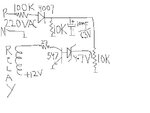mcbbcn
Newbie level 4
Hi,
I would like to use a Power-Out Alert device (**broken link removed**) to detect a power outage and actuate/trigger a relay. Basically, I need to convert the continuous signal of the power-out sensor into one single-shot or single pulse signal.
The power-out alert device has a cable with two wires (a common wire and a N.O. wire) and when the power goes out it trips both wires for as long as the condition exist. Similar to safety lights with a motion sensor, when the motion sensor detects motion, it triggers a continuous alarm signal and the lights turn on.
I've read about the 555 monostable circuit but unfortunately my knowledge about electronics is limited so I'm not sure this is what I need and how to do it.
I was wondering if a kind soul could take a look at the above link and tell me if I'm going down the right path with a 555 monostable circuit.
Thanks for your help,
Miquel Casas
Portland, OR
I would like to use a Power-Out Alert device (**broken link removed**) to detect a power outage and actuate/trigger a relay. Basically, I need to convert the continuous signal of the power-out sensor into one single-shot or single pulse signal.
The power-out alert device has a cable with two wires (a common wire and a N.O. wire) and when the power goes out it trips both wires for as long as the condition exist. Similar to safety lights with a motion sensor, when the motion sensor detects motion, it triggers a continuous alarm signal and the lights turn on.
I've read about the 555 monostable circuit but unfortunately my knowledge about electronics is limited so I'm not sure this is what I need and how to do it.
I was wondering if a kind soul could take a look at the above link and tell me if I'm going down the right path with a 555 monostable circuit.
Thanks for your help,
Miquel Casas
Portland, OR
